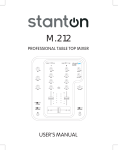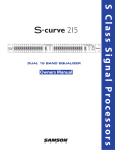Download Samson Q5 Specifications
Transcript
H E A D P H O N E AMPLIFIER SAMSON Q5 ® Introduction 3 System Features 4 Guided Tour 5 Front Panel 5 Rear Panel 6 Setting Up and Using the Q5 7 Using the Q5 with a Patchbay 9 Linking Multiple Q5s 10 Reference Chart A: Headphone Impedance and Sensitivity Ratings 11 Reference Chart B: Impedance vs. Wattage 12 Specifications 13 Introduction Congratulations on purchasing the Samson Q5 Headphone Amplifier! Although this unit is designed for easy operation, we suggest you take some time out first to go through these pages so you can fully understand how we’ve implemented a number of unique features. The Q5 is a compact, high-quality device that allows you to monitor any stereo or monophonic source signal (balanced or unbalanced) over as many as five separate headphones. Providing unusually high power levels and superb audio fidelity, the Q5 is compatible with virtually all popular headphone models. Front panel controls include a master input level control and stereo/mono switch, and each headphone output has its own individual level control. Special output jacks on the rear panel allow any number of Q5 units to be linked together with no loss of signal. The Q5 can be used in a wide variety of applications, including recording studios, teaching labs, broadcast environments, and for live performance. In this manual, you’ll find a more detailed description of the features of the Q5, as well as a guided tour through the front and rear panels, stepby-step instructions for using the Q5, a reference chart that gives impedance and sensitivity ratings for a number of popular headphone models, and full specifications. You’ll also find a warrantee card enclosed— please don’t forget to fill it out and mail it so that you can receive online technical support and so we can send you updated information about other Samson products in the future. 3 System Features The Samson Q5 Headphone Amplifier utilizes state-of-the-art technology. Here are some of its main features: • Special voltage doubler circuitry allows the Q5 to deliver unusually high output levels while maintaining excellent audio fidelity regardless of the number or type of headphones connected. • Individual level controls for each headphone output allow customized gain settings for each user, no matter what type of headphone is used. This enables each user to connect the headphone model of his or her choice, with no audible effect on other users. • Electronically balanced input connectors (these also accept unbalanced input signal) that enable the Q5 to be used with a wide variety of audio equipment, from professional-level mixing consoles to home hi-fi devices. • Need more than five headphones? No problem—a unique electronically balanced Stereo Link output allows any number of Q5s to be linked together with no loss of audio fidelity or output level. • A master input level control that allows optimum input level to be set, maximizing signal-to-noise ratio in all applications. • A master mono/stereo button allows instant switching between the two modes and also allows an incoming stereo mix to instantly be checked for mono compatibility. 4 Guided Tour - Front Panel 4 0 −∞ CHANNEL 3 CHANNEL 2 CHANNEL 1 +10 0 −∞ +10 CHANNEL 4 0 −∞ +10 CHANNEL 5 +10 1 POWER INPUT 0 0 −∞ 2 −∞ +10 MONO STEREO OFF 10 ® Q5 HEADPHONE AMPLIFIER 5 3 1: Input Level / Power knob - Use this to adjust the input level of incoming signal and to switch the main power on and off (turn fully counterclockwise to switch the power off). When the Q5 is on, the “Power” LED (see #2 below) will be lit. Turning the knob clockwise will increase the gain of incoming signal; turning it counterclockwise will decrease the gain. 2: Power LED - When the Q5 is on, this LED will light bright red. 3: Mono/Stereo button - When out, all five headphone outputs will reproduce the incoming signal in stereo. When pressed in, all five headphone outputs will reproduce the incoming signal in mono. The setting of this button does not affect the rear panel Left/Right Stereo Link Outputs (see next page). 4: Channel Output knob - Adjusts the output level of the signal sent to the headphone connected to the jack immediately below. Turning the knob clockwise will increase the gain of the output signal to that headphone; turning it counterclockwise will decrease the gain. 5: Channel Headphone jack - Connect any standard pair of stereo headphones to each of these standard 1/4” stereo jacks. The level of the signal sent to the headphones is determined by the setting of the Channel Output knob immediately above that jack. 5 Guided Tour - Rear Panel STEREO LINK BALANCED +14dB MAX. INPUT BALANCED Q5 HEADPHONE AMPLIFIER DISTRIBUTION LEFT AMP INPUT RIGHT AMP INPUT LEFT 4 LINK RIGHT AMPLIFIER 500mW 600 Ω TRS WIRING LINK WIRING PHONES WIRING TIP + RING SLEEVE GROUND TIP + RING SLEEVE GROUND TIP LEFT RING RIGHT SLEEVE GROUND SERIAL NUMBER SAMSON TECHNOLOGIES CORP., HICKSVILLE, NEW YORK 1 16VAC ASSEMBLED IN R.O.K. 3 2 1: AC input - Connect the supplied Samson AC16 16-volt AC power adapter here. Do not substitute any other kind of power adapter; doing so can cause severe damage to the unit and will void your warrantee. 2: AC16 16-volt AC power adapter - Designed specifically for use with the Q5 Headphone Amplifier. 3: Left/Right Stereo Link outputs - Use these electronically balanced 1/4” TRS (Tip/Ring/Sleeve) jacks to link together multiple Q5 devices. See the section in this manual entitled “Linking Multiple Q5s” for more information. 4: Left/Right Amp inputs - Connect incoming signal to these standard 1/4” TRS (Tip/Ring/Sleeve) jacks. Input may be balanced or unbalanced, to a maximum input level of +18 dBV. 6 Setting Up and Using the Q5 Setting up your Q5 Headphone Amplifier is a simple procedure which takes only a few minutes: 1. Remove all packing materials (save them in case of need for future service) and plug the provided AC16 power adapter into the rear panel AC input—but don’t plug the adapter into a wall outlet just yet. WARNING: Do not substitute any other kind of power adapter for the provided one. The provided adapter is an AC step-down transformer; it is not a DC converter. Use of any power adapter other than the provided one can result in severe damage to the unit and will void your warrantee!! 2. Connect the output from the device you want monitored to the Left/Right Amp input jacks on the Q5 rear panel (if you’re using the Q5 with an audio patchbay, see the “Using The Q5 With A Patchbay” section on page 7). The Q5 accepts both balanced and unbalanced signal; generally, balanced signal is preferable because it provides better signal-to-noise ratio and reduced extraneous noise. 3. Turn the master Input knob and all five headphone Channel Output knobs to their minimum (fully counterclockwise) setting and then plug one to five sets of headphones into the front-panel Channel Headphone jacks. 4. Plug the Q5 power adapter into a wall outlet and switch the unit on by turning the Input Level knob clockwise. You’ll hear a click when first turning the knob and the Power LED will light up. Start by setting the knob to about the 3 o’clock position. 5. Apply a signal from the device connected to the Q5’s rear-panel Left/Right Amp input jacks. Put on the first set of headphones and slowly turn that headphone channel’s Output knob clockwise until you hear the desired level. WARNING: Because the Q5 is capable of generating extremely high signal levels, always start with the Channel Output knob at minimum and then slowly turn it up. 7 Setting Up and Using the Q5 6. Repeat step 5 for all connected headphones, making sure to start with the Channel Output knob completely counterclockwise and then slowly raising it until the desired level is achieved. If you have connected different models of headphones to the various Channel Headphone jacks, you may find that some require more gain than others to achieve the same volume. This kind of disparity will occur if the various headphones have different impedances. The lower the impedance, the louder the headphone will sound compared to another, higher impedance headphone at the same Channel Output setting. Another factor affecting headphone loudness is called sensitivity. This is generally measured by determining the decibel (dB) level generated by 1 mW of power input. The higher the dB rating, the louder the headphone. See the Reference chart on page 9 of this manual for more details. 7. To achieve optimum signal-to-noise ratio, the master Input Level should generally be set as high as possible, short of audible distortion. However, if this results in your getting blasted with signal even though a Channel’s Output is near minimum, you’ll need to decrease the master Input Level while raising one or more Channel Output levels. Conversely, if you find that you have to raise one or more headphone Channel Output knobs to maximum or near maximum to achieve the desired level, try increasing the master Input Level while decreasing the Channel Output(s). 8. To check mono compatibility of a stereo signal being input to the Q5, press the Stereo/Mono button so that it is down—all five headphone Channels will then receive the incoming signal in mono. If you have followed all the steps above and are experiencing difficulties, call Samson Technical Support (516-932-1062) between 9 AM and 5 PM EST. 8 Using the Q5 with a Patchbay If you are using the Q5 with an audio patchbay, you may find it advantageous to connect its Left/Right Amp Inputs directly to a pair of patch points. This way, you can opt to route signal to the Q5 from any source. In a recording environment, for example, you may typically use a pair of mixer Auxiliary sends for a stereo headphone (cue) mix. For maximum convenience and flexibility, we recommend that you half-normal those sends to the Q5 input patchpoints so that the connection will automatically be made unless a patch cable is inserted. If a different signal (such as a stereo bus output or a different pair of auxiliary sends) needs to be substituted, you can then override this connection simply by inserting a patch cable. 9 Linking Multiple Q5s Any number of Q5s can be linked together (“daisy-chained”), allowing you to monitor an input signal over more than five sets of headphones. To do this, simply make a connection between one Q5’s Left/Right Stereo Link outputs and the next one’s Left/Right Amp inputs, and insert open-ended “dummy” 1/4" TRS plugs into the Left/Right Stereo Link Outputs of the last Q5 in the chain, as shown in the illustration below*: +14dB MAX. INPUT BALANCED STEREO LINK BALANCED Q5 HEADPHONE AMPLIFIER DISTRIBUTION LEFT AMP INPUT RIGHT AMP INPUT +14dB MAX. INPUT BALANCED LEFT LINK PHONES WIRING TIP LEFT RING RIGHT SLEEVE GROUND RIGHT AMP INPUT LEFT LINK RIGHT SERIAL NUMBER SAMSON TECHNOLOGIES CORP., HICKSVILLE, NEW YORK 16VAC ASSEMBLED IN R.O.K. 16VAC ASSEMBLED IN R.O.K. Q5 HEADPHONE AMPLIFIER DISTRIBUTION LEFT AMP INPUT 600 Ω LINK WIRING TIP + RING SLEEVE GROUND RIGHT STEREO LINK BALANCED AMPLIFIER 500mW TRS WIRING TIP + RING SLEEVE GROUND AMPLIFIER 500mW 600 Ω TRS WIRING LINK WIRING PHONES WIRING TIP + RING SLEEVE GROUND TIP + RING SLEEVE GROUND TIP LEFT RING RIGHT SLEEVE GROUND SERIAL NUMBER SAMSON TECHNOLOGIES CORP., HICKSVILLE, NEW YORK “DUMMY” OPEN-ENDED 1/4" TRS PLUGS Because the Q5 Stereo Link output jacks are electronically balanced, we recommend the use of 3-conductor cable and 1/4" TRS (Tip/Ring/ Sleeve) connectors. Even when several Q5s are linked together this way, there is no loss of power or audio fidelity—every Channel on every Q5 will sound just as loud and clear as if it were the only unit connected. The status of the front-panel Stereo/Mono button affects only that unit and has no effect on any subsequent linked units. * Note: The AC power adapter in this illustration is not shown to scale. 10 Reference Chart A: Headphone Impedance and Sensitivity Ratings Virtually all headphones that terminate in a stereo 1/4” plug can be used with the Q5 Headphone Amplifier. This chart provides a partial listing of some of the more popular models, along with their impedance and sensitivity ratings. As described on page 6 of this manual, headphones with lower impedances (or higher sensitivity) will sound louder as compared to other, higher impedance (or lower sensitivity) headphones at the same Channel Output setting. Samson Technologies has no connection with any of these manufacturers, nor do we endorse any particular models for use with the Q5; this is simply a reference listing for your convenience. For more information about any of these headphones, contact the manufacturer directly. Manufacturer Model Impedance Sensitivity ———————————————————————————————— AKG K-141 600 ohm 98 dB AKG K-240 600 ohm 88 dB Beyer DT-150 250 ohm 114 dB Beyer DT-801 250 ohm 114 dB Fostex T-10 50 ohm 91 dB Fostex T-20 50 ohm 96 dB Fostex T-40 50 ohm 98 dB Sennheiser HD-450 (original) 70 ohm 94 dB Sennheiser HD-450 Series II 60 ohm 94 dB Sony MDR-7502 45 ohm 100 dB Sony MDR-7504 45 ohm 103 dB Sony MDR-7506 63 ohm 106 dB 11 Reference Chart B: Impedance vs. Wattage (5 channels used) Impedance Wattage ———————————————————————————————— 600 ohm 500 mW 250 ohm 484 mW 150 ohm 426 mW 100 ohm 409 mW 50 ohm 192 mW 32 ohm 180 mW 16 ohm 122 mW 8 ohm 42 mW Note: 1 channel driven (loaded) 600 ohm @ 530 mW 10 Specifications 1. Power 500 mW x 5 channel 2. Inputs Type: Low-Z balanced Transformerless 10K ohms +18dBV 3-Conductor 1/4” (tip-ring-sleeve) Input impedance: Maximum input level: Connector: 3. Indicators Power Red LED indicators power “On” 4. Frequency Response 20 Hz to 20 kHz, +0 dB > -1 dB 5. THD .003% (1 kHz, 0 dBm, 600 ohms) .006% (1 kHz, 24 dBm, 600 ohms) 6. Signal to Noise Ratio 95 dB 7. Gain 20 dB 8. Outputs Type: Output impedance: Maximum output level: Connectors: Low-Z balanced 160 ohms typical 24 dBm / 600 ohms 1/4” Stereo (x 5) 9. Minimum impedance 8 ohm 10. Power requirements 16 volts AC, 1.2 amperes 11























